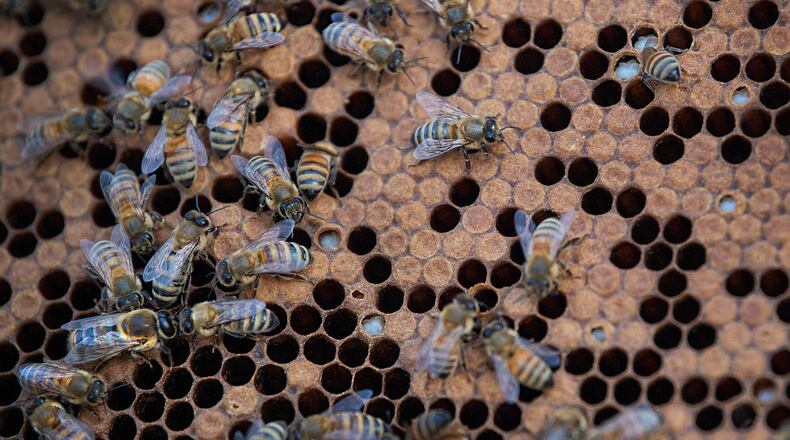Delta Air Lines is responding to criticism by pledging to update some of its protocols after a shipping mistake killed millions of bees on a hot tarmac at the Atlanta airport last month.
The bees, shipped from California, were supposed to fly to Anchorage, Alaska, via Seattle. But in an unfortunate series of events, they ended up on a flight to Hartsfield-Jackson International, where many of the pollinators languished and died in the hot Atlanta sun before some were rescued by local beekeepers.
The bizarre incident highlights an aspect of air travel and commerce that many passengers are likely unaware of — that commercial airliners carry a lot more than just humans and the mail from point A to point B.
In the cargo holds of commercial flights, airlines might haul exotic animals, livestock and other creatures, and that can complicate matters when something goes wrong.
Delta’s cargo unit can ship a variety of live animals, ranging from insects to baby chicks to primates moving between wildlife preserves or zoos. Delta bans shipment of dogs and cats used in research, as well as hunting trophies of lions, leopards, elephants, rhinos and buffalo.
Delta and some other carriers also play a critical role in shipping millions of honey bees to Alaska. The bees pollinate plants and produce honey in Alaska through the summer, but often cannot survive the winter there — which is why beekeepers in the state are reliant on massive shipments of new bees each spring.
There are risks involved in shipping live animals, but it’s unclear how many die during their journeys. Deaths of live animals shipped for commercial purposes — other than cats and dogs — are not counted in the U.S. Department of Transportation’s monthly count of pets that are lost, injured or die during air transport.
Atlanta-based Delta said in a statement that it apologized to the Alaska customer “for the unfortunate situation” and took “immediate action to implement new measures to ensure events of this nature do not occur in the future.”
But the airline declined to outline those new procedures.
In recent years, concern has grown globally about a decline in bee populations, which are crucial for pollinating crops.
Some local beekeepers said they want better training for airline workers handling bee shipments.
Missed connection
Sarah McElrea, the Alaska bee distributor who ordered the bees for shipping on Delta, told customers in a Facebook post that her bees missed their original flight from Sacramento to Seattle in late April because the airline changed aircraft types and the boxes wouldn’t fit on a smaller plane.
Instead, the bees were rerouted all the way to Atlanta to eventually connect to a flight to Anchorage.
But once at Hartsfield-Jackson, the bees’ connection was delayed because of a broken cargo tie-down in the aircraft, McElrea said. After the bees were removed from a cooler to await boarding outside, Delta workers reported that the bees were escaping their enclosure, so they were not loaded.
Bees can fly up to three miles, and McElrea said she suspects the loose bees were local ones attracted by her bees’ pheromones. In fact, tens of thousands of bees live in hives installed in 2018 just across the street from the airport on Delta’s corporate campus.
It’s unclear if any of those bees might have interacted with McElrea’s hives.
McElrea said Delta told her she would have to pick up her bees in Atlanta. Instead, she enlisted the help of Atlanta area beekeepers to take them home. Members of the Metro Atlanta Beekeepers Association responded, but found most of the bees had already died, said Marietta beekeeper Jimmy Gatt.
Gatt said it’s hard to tell if the bees recovered from the Delta shipment will survive.
“We don’t know how bad they were stressed,” he said.
Transport troubles
The perception of a swarm of bees complicates shipping.
After a shipment of bees on Alaska Airlines died during a layover in Seattle five years ago, a Quartz article pointed to the perils of transporting the pollinators and said bees “are easily stressed, and sensitive to temperature changes.”
Periodically, trucks carrying bee shipments have crashed and unleashed swarms that alarmed drivers and nearby residents, according to news reports.
It’s not unusual for as many as 50 million bees to die after such wrecks when the fire department sprays them with foam as they work to clear the road, said Georgia beekeeper Dale Richter. He has been trying to start a system to alert area beekeepers to incidents to save the bees.
McElrea has been working to get replacement bee shipments to her customers — and still had challenges getting them on flights. Over the last week, she went to California to pick up more bees for customers, then drove them to Seattle to fly them to Alaska.
“The biggest hurdle seems to be the Sacramento to Seattle leg of the journey,” she posted on Facebook. “This is where the [flight] changes continue to happen at the last minute, and is where our bees are the most vulnerable to being rerouted.”
Getting bees to Alaska takes work and the lives of the pollinators are sadly short. Some beekeepers have tried overwintering bees in Alaska, but it’s challenging.
“The honey flow usually ends the middle of August, but many people wait until the first of September to kill their bees,” according to the University of Alaska Fairbanks.
About the Author
The Latest
Featured



